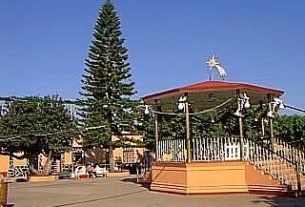What can we say? It is now November and it has already been cold; cold like late December when the chill in the air sends us under the covers at night. Without the heating systems we knew north of the border, how can we keep the house warmer?
 A common issue here in Mexico is that the homes are generally very “leaky.” Windows and doors are typically not sealed like windows up north and small drafts can sneak through the doors and windows. Other sources of drafts are the ventilated skylights we enjoy during the hotter months. Even fireplaces, when not in use, become an entry point for cool air since typically fireplaces do not have a damper control.
A common issue here in Mexico is that the homes are generally very “leaky.” Windows and doors are typically not sealed like windows up north and small drafts can sneak through the doors and windows. Other sources of drafts are the ventilated skylights we enjoy during the hotter months. Even fireplaces, when not in use, become an entry point for cool air since typically fireplaces do not have a damper control.
Skylights and fireplaces
Skylights are difficult. They can be filled from the interior or covered from above with a tarpaulin. I have seen solutions that vary from simply taping over the mosquito screen (which is not recommended) to providing a small insert made of plastic or wood to fill in the space and eliminate the draft.
In fireplaces, some people have placed aluminum foil, bricks or tiles in the throat above the firebox where the damper would normally be located. Of course, one should always remember to remove these items prior to lighting a fire.
Working with nature
However, sometimes we miss the opportunity to warm our house a natural way. Most homes have the passive capability to act as large solar sinks that can absorb a large amount of solar energy by heating up the house. The massive masonry construction slowly absorbs infrared energy and heats up the bricks, steel and cement during the day. But during the night, the reverse happens: the heat energy that was absorbed by the building during the day is slowly released after sunset. This sometimes can keep a home warm for several hours during the evening.
In winter months, it is advantageous to open the curtains, pull aside the potted plants and let the sun shine in. Because the sun is lower on the horizon, there is the opportunity for more the sun to shine into the house and heat up the floors in the interior of the house. Similarly, the floors will slowly release the heat and keep your toes toasty warm through the evening.
Alternative heat sources
This method of passive solar heating is an easy way to help warm your home. However, if the sun is not shining, there are many ways to help heat up the home using alternative heat sources like your fireplace or space heaters during these cooler and cloudy days.
Some homeowners have decided to use a “non-vented” or “no-vent” gas fireplace insert which does not require a chimney or ventilation system and can produce large amounts of heat energy (BTUs or kilowatts). These types of heaters are illegal in Canada and many of the states in America. In Mexico, the leaky conditions of our houses help since, if these heaters produce excessive carbon monoxide or water vapor (water vapor, carbon dioxide and potentially carbon monoxide are byproducts of gas combustion), they usually can be diluted or allowed to escape the leaky home.
If you decide to use a “no-vent” gas insert in your fireplace, consider a carbon monoxide detection unit or use the system only for short durations of time to help heat up the house before going to bed.
Safety note about electrical space heaters
Let’s remember that electrical heaters should be connected to a grounded circuit for safety reasons. Unfortunately, this past year someone accidentally died here at Lake Chapala as the result of a faulty space heater used on a non-grounded circuit in a bathroom.
If you are using a space heater — whether gas or electric — please be sure the heater is placed in a safe location that is not on or pointing directly at combustible materials.


